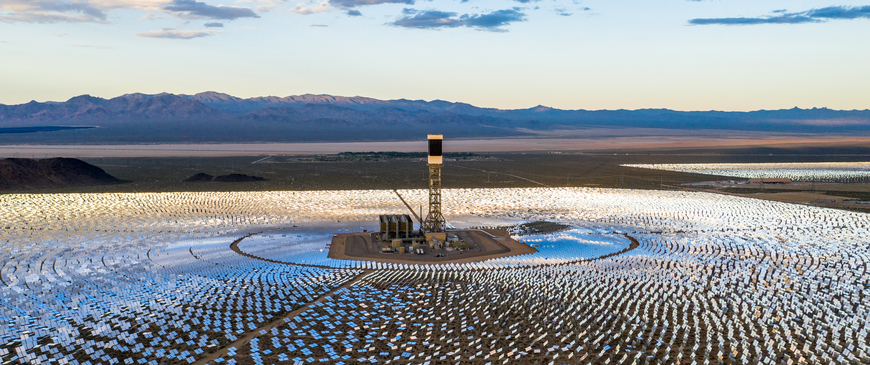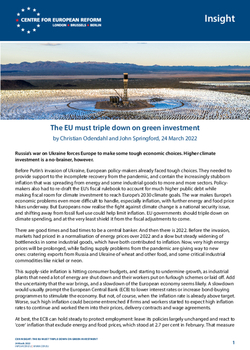
The EU must triple down on green investment
Russia’s war on Ukraine forces Europe to make some tough economic choices. Higher climate investment is a no-brainer, however.
Before Putin’s invasion of Ukraine, European policy-makers already faced tough choices. They needed to provide support to the incomplete recovery from the pandemic, and contain the increasingly stubborn inflation that was spreading from energy and some industrial goods to more and more sectors. Policy-makers also had to re-draft the EU’s fiscal rulebook to account for much higher public debt while making fiscal room for climate investment to reach Europe’s 2030 climate goals. The war makes Europe’s economic problems even more difficult to handle, especially inflation, with further energy and food price hikes underway. But Europeans now realise the fight against climate change is a national security issue, and shifting away from fossil fuel use could help limit inflation. EU governments should triple down on climate spending, and at the very least shield it from the fiscal adjustments to come.
There are good times and bad times to be a central banker. And then there is 2022. Before the invasion, markets had priced in a normalisation of energy prices over 2022 and a slow but steady widening of bottlenecks in some industrial goods, which have both contributed to inflation. Now, very high energy prices will be prolonged, while fading supply problems from the pandemic are giving way to new ones: cratering exports from Russia and Ukraine of wheat and other food, and some critical industrial commodities like nickel or neon.
This supply-side inflation is hitting consumer budgets, and starting to undermine growth, as industrial plants that need a lot of energy are shut down and their workers put on furlough schemes or laid off. Add the uncertainty that the war brings, and a slowdown of the European economy seems likely. A slowdown would usually prompt the European Central Bank (ECB) to lower interest rates or increase bond-buying programmes to stimulate the economy. But not, of course, when the inflation rate is already above target. Worse, such high inflation could become entrenched if firms and workers started to expect high inflation rates to continue and worked them into their prices, delivery contracts and wage agreements.
At best, the ECB can hold steady to protect employment: leave its policies largely unchanged and react to ‘core‘ inflation that exclude energy and food prices, which stood at 2.7 per cent in February. That measure of inflation better captures the present state of the economy. But if it moves further above target, and if wage demands start factoring in high inflation expectations, the ECB would have no choice but to end asset purchases and then raise interest rates to ensure that high inflation did not become entrenched. Higher rates would weaken the economy somewhat in the short term; that is the way through which ECB rate-setting affects the economy. That is why other policies are needed to contain inflation.
First, governments should encourage trade unions and firms to agree one-off pay bonuses to workers, and keep permanent wage rises modest. High wage settlements would drive inflation higher still as firms adjust their prices to reflect higher permanent costs. Such second-round effects of higher energy prices would then prompt the ECB to raise interest rates. One-off payments are less likely to be reflected in firms’ medium-term price calculations, while still appropriate to divide the economic loss caused by higher energy costs between the owners of companies and workers.
Second, governments should compensate consumers with one-off cash payments to help with rising prices, without giving in to the temptation of fiddling with energy prices themselves (as France, among others, has decided to do). Energy price signals need to be preserved, to make sure firms and consumers save energy where they can. With compensation from the state, there is also a good chance that wage settlements will be lower, because workers’ incomes will have received some protection. That would further contain second-round increases in prices. Countries that do not yet have systems for providing one-off payments to citizens directly should set them up: such systems could be used again when carbon prices are higher and the proceeds need to be redistributed in the form of climate dividends.
Third, governments will have to support efforts to curb the burning of fossil fuels. It will take time to insulate houses and install wind turbines. But insulating Europe’s housing stock has become more urgent, and various other measures would rapidly save energy or promote green electricity. The International Energy Agency (IEA) reckons that easing planning restrictions on solar plants, or subsidising heat pumps and smart thermostats and meters could generate sizeable cuts in fossil-fuel consumption in 2022. Governments should refrain from subsidies to industries which are facing big supply constraints hindering production, as this would not do much to raise sales (electric car manufacturers are struggling with a shortage of chips, for example). Beefing up investment in charging infrastructure for electric cars, however, would lay the ground for when constraints on car production ease.
Climate investment has always been a matter of national security. Russia’s war on Ukraine has simply brought this to everyone’s attention. The European Commission’s ‘Repower EU’ plan, published on March 8th, proposes to reduce Europe’s dependence on Russian energy imports by two-thirds in 2022. Most of the proposals are about bringing green investment forward, like building wind turbines faster, rather than adding new investment. High electricity prices mean that governments need not subsidise new plants as much as they used to. Some renewable generators in Germany are selling power directly to industrial customers, because prices are so high, rather than going through the wholesale market to get feed-in tariffs. But even so, a large amount of government spending will be needed to make Europe less dependent on fossil fuels. In a new policy brief, to be published this month, we estimate that EU member-states need to spend 1 per cent of GDP more to keep on track to reach 2030 climate goals.
Moreover, the challenge that Russia poses to Europe’s security is much wider than energy. Germany has announced that it will spend 0.5 per cent of its GDP more on defence, bringing spending above 2 per cent of GDP. Sweden and Finland are considering joining NATO. At present, only Estonia, Greece, France, Cyprus, Latvia, Lithuania, Poland and Romania exceed or are close to the NATO commitment to spend 2 per cent of GDP on defence. Spending would have to rise by around 0.7 per cent of GDP if all EU countries decided to re-arm to that level.
More spending on energy, defence and refugees this year and next is a given, thanks to Putin’s invasion, but central banks may be forced to raise interest rates, making government borrowing more expensive. So how should governments raise the funds for more investment in defence and energy security? (Whether they can afford it is the wrong question, as Europe certainly cannot afford to jeopardise its security or the climate). There are three options: taxation, national borrowing or European joint borrowing.
Raising taxes is hard, especially at a time when real incomes of households are being squeezed by inflation, and firms are struggling with bottlenecks in their supply chain and the uncertainty of war. But some higher taxation will be needed, especially in countries that have high deficits and low growth prospects. Taxes on pollution are one option. When world cereal production is seriously threatened – Ukraine is a major exporter – using agricultural land for livestock is a questionable use of limited resources. Carbon emissions from meat and milk production are not priced, and the current crisis is the moment to raise taxes on meat and dairy. While doing so would raise meat and dairy prices, it would help to contain other food prices by encouraging farmers to grow wheat and other crops instead of animal feed.
Similarly, companies extracting fossil fuels and some firms along the energy supply chain like refineries are making large profits at the moment, on the back of an unexpected war. Some of these windfalls could be taxed, ideally in a way that rewards diversification, security of supply and green energy, to ensure that investment incentives are not just intact but strengthened. Getting that balance right is difficult. Take windfall taxes on renewables producers, who thanks to high electricity prices are also making big profits. These investors are always vulnerable to some expropriation by governments because they have high up-front investment costs but their operating costs are low. They should be excluded from any windfall taxes, to maintain the incentive to invest in renewable. At the same time, fossil fuels in Europe are subsidised by 0.4 per cent of GDP per year, most of those subsidies economically unjustified and harming the climate. The EU and its member-states should use the opportunity of high prices to end these subsidies once prices start coming down.
National borrowing is the second option. Governments in Europe have borrowed heavily to manage the pandemic, bringing average debt levels in the eurozone close to 100 per cent of GDP. The famous – or infamous – legal debt limit in Europe is 60 per cent. The International Monetary Fund (IMF), in its most recent analysis of Italy’s debt, concluded that the current level of around 150 per cent of GDP is sustainable, but moderately slower growth than its forecast would make the debt level rise substantially. But national borrowing for climate investment, given the need to stop handing billions to the Kremlin, will be impossible to avoid: making countries less vulnerable to energy blackmail will bring economic benefits, too, because volatile fossil fuel prices would be less damaging in the future.
Finally, Europe could borrow collectively. During the pandemic, Europe has found common resolve in fiscal policy few thought it could gather. Considering that Europe’s security (and once more its economic recovery) is at stake, it is also in the interests of the richer North that the East and the South are able to invest. The Recovery and Resilience Facility (RRF) is a smart combination of transfers from richer to poorer member-states, and cheap loans (in effect, subsidised national borrowing), in return for reforms and investment commitments. Europe should put together a RRF 2.0 to focus on energy that is green and secure, that is, on projects that can rapidly reduce the need for imported fossil fuels. That would make Europe as a whole less vulnerable to Russia, and will allow all countries to invest in energy and defence with the same boldness that Germany has done.
European policy-makers should use this crisis to secure the triple dividend that green investment can bring: make Europe less dependent on Russian energy, help fight inflation and reduce Europe’s carbon emissions. Match that with a triple funding of taxation, national and European borrowing, and Europe will have made another big step forward towards meaningful integration where it matters: in protecting two of Europe’s most important public goods, security and a stable climate.
Christian Odendahl is chief economist and John Springford is deputy director of the Centre for European Reform.
This work is being supported by a grant from the European Climate Foundation.


Add new comment